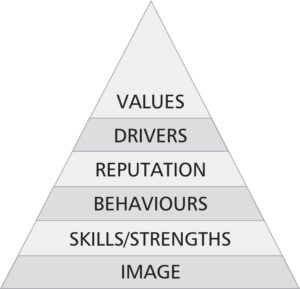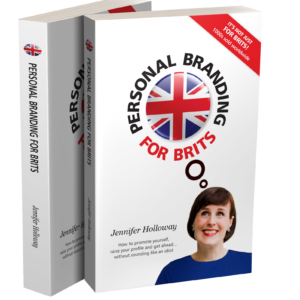

Personal Brand 101 – Part 2
If you’ve already read Part 1 of this Personal Brand 101, you’ll know that a personal brand comprises two factors – your ‘what’ and your ‘who’.
Knowing that is one thing, but actually using that knowledge to define your own personal brand is quite another. That’s where Part 2 steps in – to take that broad-brush view and give it some added structure, using the Personal Brand Pyramid I introduced before.
Just like the similarly structured Hierarchy of Needs by Abraham Maslow (ah, that takes me back to my Sociology GCSE) the elements build on each other; those that are more readily seen and experienced by others are at the bottom, moving to the more deeply rooted ones at the top.*

So what constitutes each element?
In an effort to ensure maximum understanding and minimum confusion (see my previous post about the Curse of Knowledge) I’m going explain the elements two at a time, starting with Values and Drivers, with the others to follow in Part 3 and Part 4.
VALUES
What they are
Values are the things you believe in very strongly, particularly in terms of how you choose to live your life – your personal ethics. Think of them as setting the points on your moral compass, to help you know the difference between right and wrong. They’ll exist in both your work and personal life (though their ranking of importance might change dependent on the circumstances).
What to ask yourself to identify them
- What are my personal Values (as opposed to a company’s values)?
- What do I strongly believe is the right way to behave?
- How do I define what is right and what is wrong?
Examples of Values
- Honesty
- Fairness
- Trustworthiness
- Responsibility
- Loyalty
- Dignity
- Courtesy
- Compassion
- Authenticity
Here’s a top tip
What constitutes a Value can be confusing, so a good way to check is to imagine you’re facing a moral dilemma. Would that Value have a direct influence on the decision you made? One way to check is by inserting your Value into the following statement:
“It would be the [Value] thing to do.”
For example, “I’m taking this decision because it would be the fair / honest / loyal / genuine / compassionate / generous thing to do” works, because they’re all Values.
This helped a client of mine who was insistent that one of his Values was humour. When I asked, “Faced with a moral dilemma, would you ever decide, “I’m taking this decision because it’s the funny thing to do,” he quickly realised it wasn’t a Value, but was instead a Behaviour (something I’ll cover in Part 3).
DRIVERS
What they are
Drivers are the things that motivate you, that give you a sense of achievement or satisfaction. They’re what need to be in place for you to be happy doing what you’re doing – and they’re what’s missing when you’re unhappy.
You’ll have different Drivers in your work and personal life, so when you’re thinking about your brand, focus on the former. The reason for that is, most people’s Drivers in their personal life relate to good health and security for themselves and their family – it’s a basic need. Whereas, when you focus on what motivates you in your business or career, you’ll find a much wider variety of Drivers appear.
What to ask yourself to identify them
- What gives me a sense of satisfaction or enjoyment in my work?
- When I’m happy at work, what need is being met?
- What’s the part of my job I enjoy most – what makes it enjoyable?
IMPORTANT: There’s a close tie between your Values and Drivers, so you may find one feeding into the other eg if your Value is honesty, your Driver might be being able to speak the truth.
Examples of Drivers
- Freedom to make my own decisions
- The ability to stay true to my Values
- Challenging the norm
- Nurturing others’ potential
- Having high calibre clients
- Being recognised as the ‘go-to’ person for my area of expertise
- Adding tangible value to my clients
Here’s a top tip
One way to think about what makes you happy in your job is to think about what makes you unhappy. Look back on your career and pinpoint the time in a job when you had to force yourself to go to work because it was the last place you wanted to be. What was making you unhappy? The flip-side of that will be a Driver that keeps you motivated.
For example, I had a client who had worked at his company for 12 years, since it had been set up. In the early days, the company’s focus was on standing up for the little guy and taking on the sector’s giants, which had been overcharging customers unchallenged. He’d loved his job at first, but had begun to dread going to the office.
The reason why wasn’t obvious – he did the same job, with the same people, in the same location – but then he realised: as the company had grown, its focus had changed. It no longer stood up for the little guy and instead had become another giant of the sector. Realising that helped him see that a key Driver for him was to work for a business that treated its customers ethically.
So there you have it – the first two elements of the Personal Brand Pyramid explained. In Part 3, we’ll look at Reputation and Behaviours, so be sure to tune in! And if I’ve not managed to overcome the Curse of Knowledge and you’re still a little unclear what’s what, feel free to ask a question using the comment box below.
*You can put the elements in whatever order suits you. Some people I’ve worked with have felt the Values should form the base of the pyramid. It doesn’t matter, so long as all six elements are there.








Leave a Reply